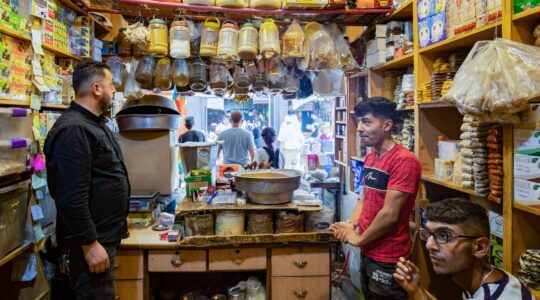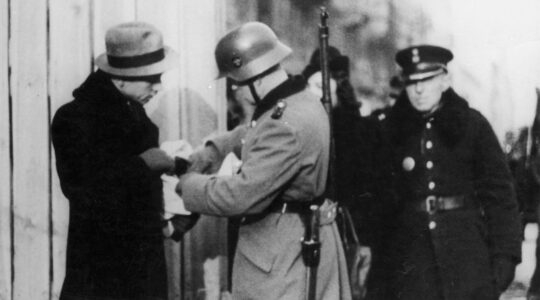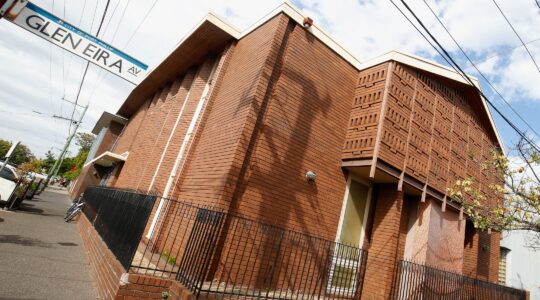
Of all the spots on the Jewish map where I could have spent Purim, I never would have chosen Barcelona. But the itinerary worked out this way and it wound up being one of those random experiences that I’ve come to appreciate doing this job.
The evening began at the Moroccan synagogue here, where only one person got up the gumption to talk to me in extremely broken Hebrew, the only language we shared. He was moved to say hello because I was following the megillah reading on an iPhone app and he made some joke about a guy sitting two rows away and following along in a scroll dating from the time of the Inquisition. "He has the oldest one and you have the newest," he said. Or at least I think that’s what he said. We both laughed anyway.
Afterwards I hung around uncomfortably in the lobby — again, no one wanted to chit chat — until I heard some English. It was a family from Albany on vacation and I told them about a party happening around the corner. So we all traipsed up a hill to an Israeli-owned pizza/falafel joint only to find the party didn’t start for another hour. They bailed. I sipped water and waited.
Eventually some revelers showed up in full Purim regalia and I met the most random assortment of people. A Brazilian guy who told me his grandfather had sent a helicopter to fetch his father from a Rio yeshiva and bring him home to Sao Paulo. A Barcelona native with perfectly unaccented English who actually reads TWJ and proudly told me he works just two hours a day boring holes under the city for a new metro line. An Israeli girl who wouldn’t tell me anything about herself other than that she is in Barcelona "living." A fifty-something French-Italian who only dates women two decades his junior. An Argentinian Jew whose job fell through and is currently living on the streets. And of course lady Madonna (pictured), who told me she’s not even Jewish but she likes to use those yarmulkes on her knees for a sex position I won’t describe.
I was surprised by the youth and the vibrancy. After visiting more small and dying Jewish communities than any person ought to, I didn’t expect to see so many 20-somethings. But there they were.
It was doubly a shock because I’ve been musing a lot on the loss of Spanish Judaism. I say lost because while there’s a small community living here today, there’s virtually nothing remaining from the hundreds of years of Jewish history preceeding the expulsion in 1492, the so-called Golden Age of Spanish Jewry.
And not only are the Jews long gone, but the physical remnants of their history are few and far between. In Barcelona, I visited a synagogue dating from the third century (consider that for a moment) and believed to be the oldest in all of Europe. It required navigating a maze of claustrophobic alleyways that are among the most byzantine of any ancient quarter I’ve visited. I was helped along by a hotel concierge who had to draw me a map on the back of a business card.
When I finally got there, I was struck by how little there is to look at. The location of the synagogue had been a mystery for five centuries. No one knew where it was until the late 1980s when a historian, using documents concerning the tax collection scheme for the Jewish quarter, managed to locate the one building whose southeast orientation, towards Jerusalem, was at odds with the rest of the quarter.

Inside, there’s virtually nothing left, a pile of stones underneath glass panels. Silver plates of Judaica, made in Germany of all places (how’s that for irony), are in glass cases along the walls. It’s the only thing that gives the place any kind of Jewish feel. That and the Israeli guy who asked for 2.5 Euros before he would give me a three-minute explanation of the building’s history. From the window of an apartment on the second floor hung a for sale sign.
Over the past decade, there’s been a concerted effort to discover, preserve and develop Jewish heritage sites in Spain, which is the subject of a larger story I’ll be filing in the next few weeks. Much of this is motivated by the lure of mythically wealthy Jewish tourists from America.
But some of it is clearly a genuine desire to rediscover a lost part of Spanish culture, much in the way the Polish government has invested millions in a museum and Jewish cultural festivals. Belatedly, Europe has discovered what it lost in its centuries-long war against the Jews.
I have to admit, I felt a little uncomfortable hearing non-Jewish Spaniards speak longingly of a Jewish life that exists only in their imaginations. And it brought to mind that awful line you sometimes hear — mostly from folks who think Israel isn’t beating on the Palestinians enough — that the only kind of Jews Europeans like are the dead kind.
Evidently I’m not the only one who feels this way. Some local Jews, and even the Israeli government (or so I’m told, I’m looking into this), feel that Spain is profiting off the backs of long-dead Jews. This isn’t Spanish heritage to be developed as a tourist attraction, they say, it’s Jewish patrimony.
This afternoon I had coffee with a French-Israeli architect who has lived a long time here who argued this is the wrong debate to be having. The question, Daniel Soleru told me, is "shayachut" (Hebrew for "connection), not "baalut" (ownership).
"When Spaniards tell you it’s their heritage after kicking the Jews out 500 years ago, it’s a funny situation," he said. "But those people living and dying here, they weren’t living on the moon. They were part of this context. The idea is how to reinscribe this history in this context. That is the challenge."
Indeed. And what a challenge it is, when the people who are doing that encribing are almost all non-Jews and there’s only a tiny local community to give life that what for them exists only in books.
Speaking of books, in the Book of Esther, there’s a line where Haman describes the Jews as a small, scattered people living in the king’s lands, but who observe different customs and speak a different language. It was on that basis that they were singled out as objects worthy of hatred and massacre. Purim celebrates the Jewish triumph over Haman’s designs. And it was more than a little odd hearing that read in a land where that triumph failed so spectacularly to materialize.
JTA has documented Jewish history in real-time for over a century. Keep our journalism strong by joining us in supporting independent, award-winning reporting.





